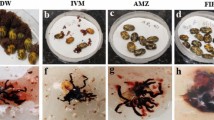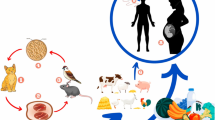Abstract
The aim of this study is to evaluate the efficacy of the eprinomectin pour-on in naturally Oestrus ovis-infested sheep. To carry out this trial, 14 naturally infected sheep from the same flock were used. The animals were randomly distributed in three groups: group 1 (non-treated sheep), group 2 treated with 0.5 mg/kg bodyweight and group 3 treated with 1 mg/kg bodyweight of eprinomectin. The sheep were slaughtered 15 days after treatment and their heads were sectioned to count and identify larvae instar. The following results were obtained: Group 1: the average was 34 live and 0.75 dead larvae per sheep. Group 2: the efficacy of the eprinomectin was 83.5% against O. ovis group 3: the efficacy of the eprinomectin pour-on was 100%. Drug analysis was made to determine plasma eprinomectin concentration 9 days after treatment and the average concentrations in groups 2 and 3 were 1.23 and 3.04 ng/ml, respectively. The statistical study showed a significant difference between the efficacy and the dose used, and there was correlation between the plasma concentration of eprinomectin and the dose. The efficacy and easy application allow us to take into account this endectocide as an alternative method in the integral control of parasites in sheep.
Similar content being viewed by others
References
Alcaide M, Reina D, Sánchez J, Frontera E, Navarrete I (2003) Seasonal variations in the larval burden distribution of Oestrus ovis in sheep in the South-West of Spain. Vet Parasitol 118:235–241
Alcaide M, Frontera EM, Sánchez-López J, Domínguez-Alpízar JL (2004) Epidemiología de la Oestrosis ovina y caprina. Ovis 92:21–35
Alcaide M, Reina D, Sánchez-López J, Frontera E, Navarrete I (2005) Seroprevalence of Oestrus ovis (Diptera, Oestridae) infestation and associated risk factors in ovine livestock from Southwestern Spain. J Med Entomol 3:327–331
Alvinerie M, Lacoste E, Sutra JF, Chartier C (1999a) Some pharmacokinetic parameters of eprinomectin in goats following pour-on administration. Vet Res 23:449–455
Alvinerie M, Lacoste E, Sutra JF, Galtier P, Mage C (1999b) Pharmocokinetics of eprinomectin in plasma and milk following topical administration to lactating dairy cattle. Res Vet Sci 67:229–232
Chartier C, Etter E, Pors I, Alvinerie M (1999) Activity of eprinomectin in goats against experimental infections with Haemonchus contortus, Teladorsagia circumcincta and Trichostrongylus colubriformis. Vet Rec 144:99–100
Dupuy J, Chartier C, Sutra JF, Alvinerie M (2001) Eprinomectin in dairy goats: dose influence on plasma levels and excretion in milk. Parasitol Res 87:294–298
Habela M, Ródenas A, Antón JM, Corchero E, Peña J, Loste JM (1998) Eficacia de la ivermectina oral. Estudio de la eficacia de Oramec frente a la oestrosis ovina. Albeitar 18:16–17
Hoste H, Lespine A, Lemercier P, Alvinerie M, Jacquiet P, Dorchies P (2004) Efficacy of eprinomectin pour-on against gastrointestinal nematodes and the nasal bot fly (Oestrus ovis) in sheep. Vet Rec 154:782–785
Lespine A, Sutra JF, Dupuy J, Alvinerie M (2003) Eprinomectin in goats: assessment of subcutaneous administration. Parasitol Res 89:120–122
Pedrera JD, Nieto CG, Pérez F, Habela MA, Mínguez MP, Reina D, Serrano F, Leal A (1989) Oftalmomiasis por larvas I de Oestrus ovis en el hombre. VI Congreso Nacional y I Congreso Ibérico de Parasitología 25–29 September 1989 Caceres (Spain): 299–300
Raynaud JP (1970) Etude de l’efficacité d’une technique de coproscopie quantitative pour le diagnostic de routine et le contrôle des infestations parasitaires des bovins, ovins, equins et porcins. Ann Parasitol Hum Comp 45:321–342
Shoop WL, Egerton JR, Early CH, Haines HW, Michael BF, Mrozik H, Eskola P, Fisher MH, Slayton L, Ostlind DA, Skelly BJ, Fulton RK, Barth D, Costa S, Gregory LW, Campbell WC, Sward RL, Turner MJ (1996a) Eprinomectin: a novel avermectin for use as a topical endectocide for cattle. Int J Parasitol 26:1237–1246
Shoop WL, Demontigny P, Fink DW, Williams JB, Egerton JR, Mrozik H, Fisher MH, Skelly BJ, Turner MJ (1996b) Efficacy in sheep and pharmacokinetics in cattle that led to the selection of eprinomectin as a topical endectocide for cattle. Int J Parasitol 26:1227–1235
Sutra JF, Chartier C, Galtier P, Alvinerie M (1998) Determination of eprinomectin in plasma by high-performance liquid chromatography with automated solid phase extraction and fluorescence detection. Analyst 123:1525–1527
Yilma JM, Dorchies P (1993) Essai d’infestations expérimentales d’agneaux par des larves I d’Oestrus ovis. Bull Soc Fr Parasitol 11:43–47
Acknowledgement
We acknowledge Merial Laboratorios S.A. for the funding of this trial.
Author information
Authors and Affiliations
Corresponding author
Rights and permissions
About this article
Cite this article
Habela, M., Moreno, A., Gragera-Slikker, A. et al. Efficacy of eprinomectin pour-on in naturally Oestrus ovis infested merino sheep in Extremadura, South-West Spain. Parasitol Res 99, 275–280 (2006). https://doi.org/10.1007/s00436-006-0161-8
Received:
Accepted:
Published:
Issue Date:
DOI: https://doi.org/10.1007/s00436-006-0161-8




